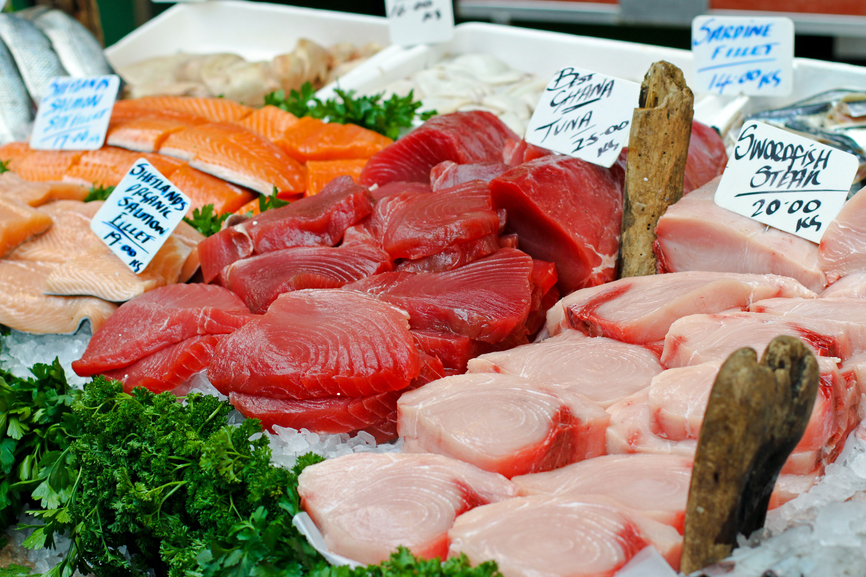Fish generally ends up on our dinner table once or twice a week. Salmon is a family favorite with other types of fish being hit or miss. About a year ago I was part of a fish CSA [2]. I loved the concept of buying fresh fish from local fishermen, but what I learned quickly was that I had a lot to do before the fish was ready to eat. The fish were delivered whole-with everything intact. That meant I had to filet it and remove all the parts that weren’t edible. For those of you who don’t know me well, I’m a bit squeamish. I don’t do well with blood, gore and guts. I tried to be a trooper and gave fileting the fish my best shot. It didn’t end well and I turned to my husband, kind friends and neighbors who took over the fileting process. As a result, my fileting days were short lived. So now I frequent the market in search of safe and sustainable fish.
Walking up to the fish counter at the grocery store or at a farmers’ market can be a bit overwhelming. The signs placed in front of each type of fish are confusing unless you know what each term means.
Here’s a general guide to buying safe and sustainable seafood:
Buy wild when possible (in most cases)
Farm-raised fish are generally placed in crowded cages and given antibiotics and exposed to pesticides. Their living environment is less than desirable. Wild fish are out in the wild-living and swimming as they were meant to be. Wild fish aren’t exposed to the same toxins as their farm-raised cousins.
Smaller is better
Larger fish generally have a higher chance of being contaminated with mercury and other heavy metals. The reason for this is bigger fish tend to live longer and have more time to accumulate these toxins. Smaller fish have a shorter life expectancy and are less likely to be polluted by heavy metals. Pregnant women and women of child-bearing age need to be careful of mercury levels in all fish, whether wild or farm-raised.
Buy local
Do you want to eat fish that traveled for days to reach your table? Think about all the fuel used for transport. Try to buy fish from a local source. [3]
Avoid added coloring
Farm-raised salmon generally has artificial color added to give it that nice pink color. When salmon are raised in a farm-raised environment they are fed “fish meal”, made up of ground fish parts, and as a result, the fish color is a shade of gray rather than pink. Coloring is added because consumers expect their salmon to look pink.
Ask questions
You have the right to know where your fish is coming from. Ask the person behind the counter or at the farmer’s market questions about added coloring, chemicals and anything else you might want to know before purchasing the fish.
More fish info
- Print out a pocket guide for buying seafood from Monterey Sea Aquarium Seafood Watch.
- Download FishFone from Blue Ocean Institute. Text them the name of the fish in question and they’ll text you back with their assessment and better alternatives to fish with significant environmental concerns.
- Check out the Environmental Defense Fund’s Seafood Selector. Their guide has fish broken down into eco-best, eco-ok and eco-worst fish.
- The Food & Water Watch site is filled with information about fish.
Take action
Say no to GE salmon HERE.
Where do you buy your fish?
